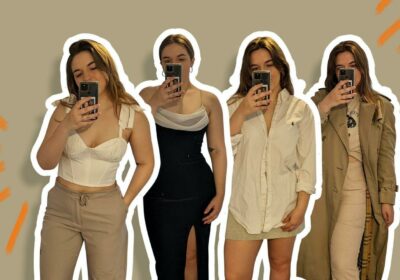“Help, I’m a secondhand shopaholic!”

Written by Amy Beecham
Charity shops and secondhand clothing apps might be better for the environment, but they can still do some serious damage to your wallet, says Stylist’s Amy Beecham.
When the year began, I promised myself that I would shop less in 2022.
The reasoning behind it was threefold. One, I’d increased my consciousness around my own, often mindless, consumerism and I wanted to take back a semblance of control. Two, while individual action in the face of a climate crisis may feel insignificant at times, it was important for me to take environmental responsibility in whatever way I could. And three, my bank account was begging me to.
I’m no stranger to an Asos delivery, but my true spending vice has always been secondhand shopping.
I’ve trawled charity shops and car boot sales for as long as I can remember, and my teenage years were spent looking for bargain trend pieces to wear to sixth form via clothes-selling apps.
While slow fashion is a huge and ever-growing force for change, I’d be lying if I claimed that the environmental ethics of a Vinted haul or charity shop splurge are the only reasons for my habit.
The truth is that I can’t resist a bargain, and when you’ve got on-trend cargo trousers for £5 and early 2000s Karen Millen dresses for under £15, can you blame me for hardly ever saying no?
Some of my best scores include floor-length 100% wool coats for £30, vintage Coach bags for £20 and some more obscure items, like my beloved St Michaels white high-waisted trousers, found for just a fiver.
My greatest ever thrift find? A Burberry trench coat, still with the Selfridges tag on it, for £50 in a Leamington Spa charity shop.
However, I’ve come to realise that such attractive prices can quickly become a slippery slope towards spending excess.
Let’s just say that after a recent audit of everything I’d added to my wardrobe, I made sure March included a month-long spending ban.
As the summer dresses, en vogue corset tops and retro denim jackets sitting on my rails can attest, in my eyes, secondhand shopping is undoubtedly a good thing.
I’m very proud that the make up of my wardrobe is at least 80% secondhand, brimming with vintage sweatshirts, on-trend blouses and wardrobe-staple wrap dresses sourced from other people’s closets.
And it seems I’m not the only one. A survey by secondhand shopping app Vinted found that a third of people claimed their favourite outfits in their wardrobe are secondhand, with 22% stating that they feel more confident when wearing secondhand clothing.
“Around the world, the pandemic has shifted priorities and accelerated an already growing movement toward more conscious consumerism that has been noticeable over the past few years,” notes Natacha Blanchard, Vinted’s consumer PR lead.
“As well as being driven by environmental factors, secondhand shopping also makes financial sense for both the buyer and the seller.”
In the face of the mind-boggling news that some fast-fashion retailers are now worth over £100 billion, it’s a small comfort to know that the slow fashion revolution is continuing to take hold.
“The fashion industry has a major impact on climate and we believe that encouraging consumption of secondhand is one part of the solution to tackling that impact,” Blanchard continues.
“However, to help normalise circular fashion, it also needs to be convenient, accessible and distribute economic value for all those involved. That’s our mission at Vinted.”
Swapping H&M for haggling at a garage sale or Dorothy Perkins for Depop won’t help us stop climate change, but finding ways to get my fashion fix while mitigating the environmental cost has truly changed the way I spend my money.
Now, if I see a new item I like, I scour secondhand sites until I find it. It’s worked a treat for everything from & Other Stories dresses to Vagabond boots to the £80 Reebok trainers that I was moments away from buying on Asos before I found them, new with tags and box, for £32.
Despite my resolutions, I don’t know if there will ever come a day that I’m able to resist giving a cute T-shirt or perfect pair of denim a new home and lease of life. But I do know that I’ll be tackling the journey towards ethical and mindful consumption in a fully thrifted ’fit.
Images: Amy Beecham
Source: Read Full Article



